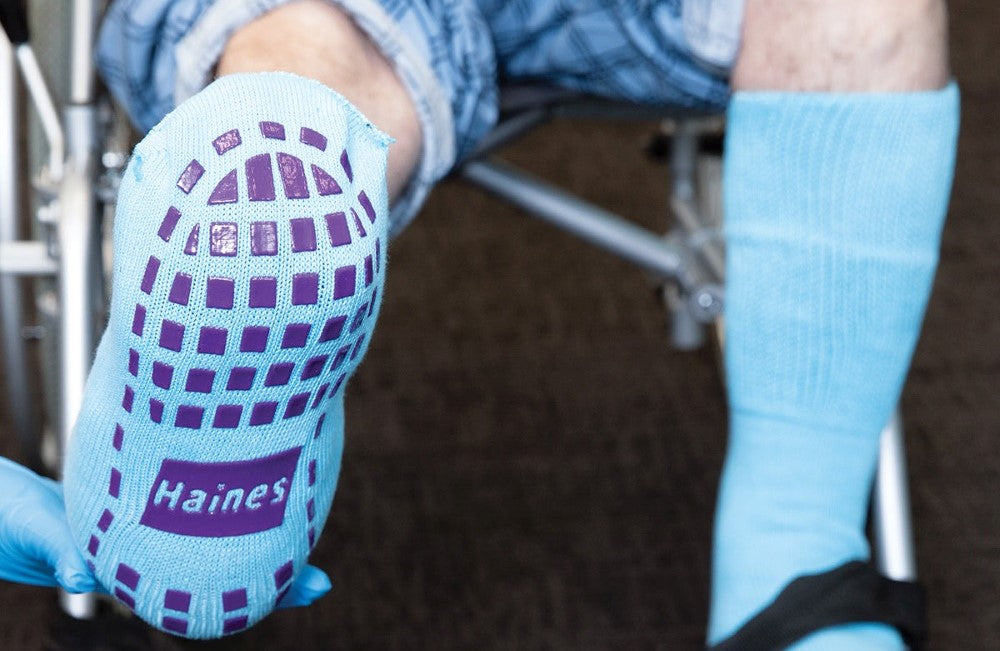The original article was provided by Haines.
Falls during recovery pose a significant concern for bariatric patients, especially those aged 65 and above. Studies indicate that one in three individuals in this age group experiences falls each year, often attributed to ill-fitting, slippery footwear (Hartung & Lalonde, 2017)¹.
Identifying Factors
Footwear choice plays a crucial role, leading to potential long-term complications for patients. Adopting a comprehensive approach is recommended to address this issue effectively (NICE, 2013; Kerse et al., 2004; Sherrington & Menz, 2003)² ³ ⁴.
Non-Slip Socks as a Consideration
Research indicates that slippery footwear not only contributes to falls but also influences walking patterns in bariatric individuals, suggesting a sense of caution. Interestingly, non-slip socks appear to offer better movement patterns compared to standard socks, potentially reducing the risk of slips (Tsai & Lin, 2013; Hatton et al., 2013)⁵ ⁶.
Evaluating Options: Single-Use vs. Reusable
In the realm of infection control and patient safety, the choice between single-use and reusable socks is a nuanced consideration. Single-use socks, when discarded between different areas, may maintain their grip over time and potentially reduce the spread of bacteria associated with patient movement (Hartung & Lalonde, 2017; Tano & Melhus, 2014)¹ ⁷.
A Broader Perspective
Acknowledging the need for continual improvement, healthcare providers explore various solutions to enhance patient and staff safety. Addressing footwear-related risks remains an ongoing aspect of our commitment to prioritize the well-being of individuals, including those on the bariatric spectrum.
[ORDER YOUR SALLYSOCKS HERE]
References
¹Hartung, Benjamin & Lalonde, Michelle. (2017). Geriatric Nursing 2017; 38 (10):1016. The use of non-slip socks to prevent falls among hospitalized older adults: A literature review.
2National Institute for Health and Care Excellence. Fas in older people: assessing risk and prevention. Available at https://www.nice.org.uk/guidance/cg161 (Accessed February 2020).
³Ngaire Kerse et al. (2004). Australian and New Zealand Journal of Public Health 28(2):180–187. Wearing slippers, falls and injury in residential care. Available at https://onlinelibrary.wiley.com/doi/abs/10.1111/j.1467-842X.2004.tb00933.x
⁴Sherrington C, Menz HB. Age Ageing. 2003;32:310-4. An evaluation of footwear worn at the time of fall-related hip fracture.
⁵Tsai YJ and Lin SI. Gait Posture. 2013 Jan;37(1):88-92. Older adults adopted more cautious gait patterns when walking in socks than barefoot. Available at https://www.sciencedirect.com/science/article/abs/pii/S0966636212002524?via%3Dihub (Accessed February 2020) doi: 10.1016/j.gaitpost.2012.06.034
⁶Anna L. Hatton et al. (2013). Journal of the American Podiatric Medical Association: November 2013, Vol. 103, No. 6, pp. 471-479. Effects of Nonslip Socks on the Gait Patterns of Older People When Walking on a Slippery Surface. Available at https://www.japmaonline.org/doi/10.7547/1030471?url_ver=Z39.88-2003&rfr_id=ori:rid:crossref.org&rfr_dat=cr_pub%3dpubmed (Accessed February 2020) https://doi.org/10.7547/1030471
⁷Tano E, Melhus A. Infection Ecology & Epidemiology 2014;4:24314. Published 2014 Nov 11. Level of decontamination after washing textiles at 60°C or 70°C followed by tumble drying. Available at https://www.tandfonline.com/doi/full/10.3402/iee.v4.24314 (Accessed February 2020)
⁸AWTA Sock Slip Test Results 23/1/2020
⁹Elizabeth A Murphy (2011). Arch Intern Med. 2011;171(3):268–269. A Key Step for Hospitalized Elders: Comment on “Early Ambulation and Length of Stay in Older Adults Hospitalized for Acute Illness”. Available https://jamanetwork.com/journals/jamainternalmedicine/article-abstract/416400 (Accessed February 2020) doi:10.1001/archinternmed.2011.1

